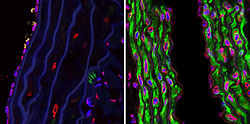Alzheimer's disease
LNK-754 inhibits the activity of a protein called farnesyl-transferase (FT). This class of molecules are called FTIs (or farnesyl-transferase inhibitors). As with mTOR inhibitors, many companies developed them to treat cancers, where they were unsuccessful. The mechanism by which FTIs work is through inhibition of this enzyme, which adds a fatty acid molecule to proteins (such as the oncogene, or cancer-generating, ras). Many proteins can exist in a cell in various locations, and the addition of a farnesyl group targets proteins to the plasma membrane. When ras gets to the plasma membrane, it becomes activated, and leads to tumour formation if this process is not stopped. It was thought that by inhibiting FT, ras will not be activated, therefore preventing cancer growth. The problem was that ras can also be modified by other mechanisms, and thus FTIs were not sufficient to inhibit malignant growth induced by ras signaling.
Most FTIs also have side effects (since they also indirectly affect mTOR), and their development for HD would likely not be successful. However, the remarkable finding is that Link Medicine has developed an FTI which does NOT affect mTOR signaling. This is a novel and important molecule, and might have higher probability to be of use for long term chronic diseases such as HD.
However, as with any new approach, it is too early yet to see if it will be safe in longer trials, and effective in people. But there is much room for hope, as this represents a completely novel mechanism to evaluate in people. If autophagy mechanisms in humans are similar as those of mice, then there is much reason for optimism. Lets hope for continued success for Link Medicine, so that it will be safe and the lead molecule progresses to the stage of being tested in HD subjects. [4]


